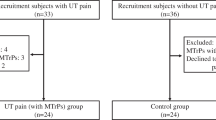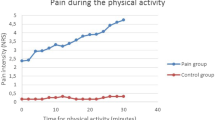Abstract
We previously demonstrated that the steadiness of shoulder abduction is reduced in patients with subacromial impingement syndrome (SIS), which might be related to shoulder pain associated with the SIS. The aim of the present study was to examine the acute effects of experimental shoulder muscle pain on shoulder motor function in healthy subjects. The fluctuations in exerted force (force steadiness) and electromyographic (EMG) activity from eight shoulder muscles were determined during sub-maximal isometric and dynamic contractions with the shoulder abductors in nine healthy subjects (27.7 ± 4.2 years, mean ± 1 SD) before, during and after experimental pain induction. Experimental pain was induced by bolus injections of 6% hypertonic saline into the supraspinatus muscle. Experimental muscle pain reduced shoulder-abduction force steadiness on average by 21% during isometric contractions (P = 0.012) and tended to do so during concentric contractions (P = 0.083). Middle deltoid, and infraspinatus and lower trapezius muscle activity increased (3–5% EMGmax) during isometric and concentric contractions, respectively (P < 0.05). Thus, experimental shoulder muscle pain reduced the steadiness of isometric shoulder abduction and caused small changes in the abduction activation strategy. The observed effects of experimental pain on shoulder motor function differed from that observed previously in patients with SIS and chronic pain during the same types of contractions. A possible explanation may be that, even though the adopted experimental pain-paradigm may reflect the SIS in terms of the painful structures, it might not reflect the adaptations in the central nervous system seen with chronic pain.



Similar content being viewed by others
References
Aagaard P, Simonsen EB, Andersen JL, Magnusson P, Dyhre-Poulsen P (2002) Increased rate of force development and neural drive of human skeletal muscle following resistance training. J Appl Physiol 93:1318–1326
Bandholm T, Rasmussen L, Aagaard P, Jensen BR, Diederichsen L (2006) Force steadiness, muscle activity, and maximal muscle strength in subjects with subacromial impingement syndrome. Muscle Nerve 34:631–639
Birch L, Graven-Nielsen T, Christensen H, Arendt-Nielsen L (2000) Experimental muscle pain modulates muscle activity and work performance differently during high and low precision use of a computer mouse. Eur J Appl Physiol 83:492–498
Ciubotariu A, Arendt-Nielsen L, Graven-Nielsen T (2004) The influence of muscle pain and fatigue on the activity of synergistic muscles of the leg. Eur J Appl Physiol 91:604–614
Diederichsen LP, Norregaard J, Krogsgaard M, Fischer-Rasmussen T, Dyhre-Poulsen P (2004) Reflexes in the shoulder muscles elicited from the human coracoacromial ligament. J Orthop Res 22:976–983
Enoka RM, Christou EA, Hunter SK, Kornatz KW, Semmler JG, Taylor AM, Tracy BL (2003) Mechanisms that contribute to differences in motor performance between young and old adults. J Electromyogr Kinesiol 13:1–12
Ervilha UF, Arendt-Nielsen L, Duarte M, Graven-Nielsen T (2004) The effect of muscle pain on elbow flexion and coactivation tasks. Exp Brain Res 156:174–182
Ervilha UF, Farina D, Arendt-Nielsen L, Graven-Nielsen T (2005) Experimental muscle pain changes motor control strategies in dynamic contractions. Exp Brain Res 164:215–224
Falla D, Farina D, Graven-Nielsen T (2006) Experimental muscle pain results in reorganization of coordination among trapezius muscle subdivisions during repetitive shoulder flexion. Exp Brain Res. doi:10 1007/s00221-006-0746-6
Farina D, Arendt-Nielsen L, Merletti R, Graven-Nielsen T (2004) Effect of experimental muscle pain on motor unit firing rate and conduction velocity. J Neurophysiol 91:1250–1259
Farina D, Arendt-Nielsen L, Graven-Nielsen T (2005) Experimental muscle pain decreases voluntary EMG activity but does not affect the muscle potential evoked by transcutaneous electrical stimulation. Clin Neurophysiol 116:1558–1565
Graven-Nielsen T, Svensson P, Arendt-Nielsen L (1997) Effects of experimental muscle pain on muscle activity and co-ordination during static and dynamic motor function. Electroencephalogr Clin Neurophysiol 105:156–164
Graven-Nielsen T, Lund H, Arendt-Nielsen L, Danneskiold-Samsoe B, Bliddal H (2002) Inhibition of maximal voluntary contraction force by experimental muscle pain: a centrally mediated mechanism. Muscle Nerve 26:708–712
Hortobagyi T, Garry J, Holbert D, DeVita P (2004) Aberrations in the control of quadriceps muscle force in patients with knee osteoarthritis. Arthritis Rheum 51:562–569
Jankowska E (1992) Interneuronal relay in spinal pathways from proprioceptors. Prog Neurobiol 38:335–378
Johansson H, Sojka P (1991) Pathophysiological mechanisms involved in genesis and spread of muscular tension in occupational muscle pain and in chronic musculoskeletal pain syndromes: a hypothesis. Med Hypotheses 35:196–203
Kendall FP, McCreary EK, Provance PG (1993) Muscles, testing and function. Williams & Wilkins, Baltimore
Kreighbaum E, Barthels KM (1996) Biomechanics—a qualitative approach for studying human movement. Allyn & Bacon, Needham Heights
Le Pera D, Graven-Nielsen T, Valeriani M, Oliviero A, Di LV, Tonali PA, Arendt-Nielsen L (2001) Inhibition of motor system excitability at cortical and spinal level by tonic muscle pain. Clin Neurophysiol 112:1633–1641
Ludewig PM, Cook TM (2000) Alterations in shoulder kinematics and associated muscle activity in people with symptoms of shoulder impingement. Phys Ther 80:276–291
Lund JP, Donga R, Widmer CG, Stohler CS (1991) The pain-adaptation model: a discussion of the relationship between chronic musculoskeletal pain and motor activity. Can J Physiol Pharmacol 69:683–694
Madeleine P, Lundager B, Voigt M, Arendt-Nielsen L (1999) Shoulder muscle co-ordination during chronic and acute experimental neck-shoulder pain. An occupational pain study. Eur J Appl Physiol Occup Physiol 79:127–140
Madeleine P, Lundager B, Voigt M, Arendt-Nielsen L (2003) The effects of neck-shoulder pain development on sensory-motor interactions among female workers in the poultry and fish industries. A prospective study. Int Arch Occup Environ Health 76:39–49
Neer CS (1972) Anterior acromioplasty for the chronic impingement syndrome in the shoulder: a preliminary report. J Bone Joint Surg Am 54:41–50
Perotto A, Delagi EF, Iazetti J, Morrison D (2005) Anatomic guide for the electromyographer—the limbs and trunk. Charles C. Thomas, Springfield
Rossi A, Decchi B (1997) Changes in Ib heteronymous inhibition to soleus motoneurones during cutaneous and muscle nociceptive stimulation in humans. Brain Res 774:55–61
Rossi A, Decchi B, Dami S, Della VR, Groccia V (1999) On the effect of chemically activated fine muscle afferents on interneurones mediating group I non-reciprocal inhibition of extensor ankle and knee muscles in humans. Brain Res 815:106–110
Schaible HG, Grubb BD (1993) Afferent and spinal mechanisms of joint pain. Pain 55:5–54
Soifer TB, Levy HJ, Soifer FM, Kleinbart F, Vigorita V, Bryk E (1996) Neurohistology of the subacromial space. Arthroscopy 12:182–186
Tracy BL, Enoka RM (2002) Older adults are less steady during submaximal isometric contractions with the knee extensor muscles. J Appl Physiol 92:1004–1012
Travell J, Rinzler S, Herman M (1942) Pain and disability of the shoulder and arm. Treatment by intramuscular infiltration with procaine hydrochloride. J Am Med Assoc 120:417–422
Vollestad NK, Mengshoel AM (2005) Relationships between neuromuscular functioning, disability and pain in fibromyalgia. Disabil Rehabil 27:667–673
Wessberg J, Vallbo AB (1995) Coding of pulsatile motor output by human muscle afferents during slow finger movements. J Physiol 485(Pt 1):271–282
Acknowledgments
The authors thank Professor Michael Kjaer for the use of laboratory facilities, Poul Dyhre-Poulsen, PhD, for his technical help, and Derek Curtis, RPT for comments on the manuscript. The project was supported in part by a grant from the Danish Foundation for Research in Physiotherapy.
Author information
Authors and Affiliations
Corresponding author
Rights and permissions
About this article
Cite this article
Bandholm, T., Rasmussen, L., Aagaard, P. et al. Effects of experimental muscle pain on shoulder-abduction force steadiness and muscle activity in healthy subjects. Eur J Appl Physiol 102, 643–650 (2008). https://doi.org/10.1007/s00421-007-0642-1
Accepted:
Published:
Issue Date:
DOI: https://doi.org/10.1007/s00421-007-0642-1




